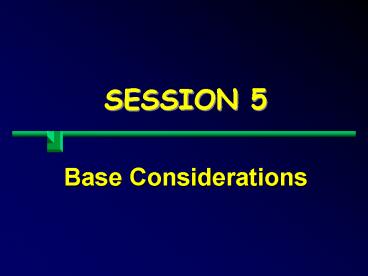Subgrade - PowerPoint PPT Presentation
1 / 25
Title:
Subgrade
Description:
May increase slab curling stresses if debonded from slab. Structural Contribution of Base ... Stiff base and low friction may increase slab curling stress ... – PowerPoint PPT presentation
Number of Views:212
Avg rating:3.0/5.0
Title: Subgrade
1
SESSION 5
Base Considerations
2
Objectives
- Describe functions of a base
- Describe different types of bases
- Describe advantages and disadvantages of each
base type - Discuss structural contribution of the base to
the pavement
3
Functions of a Base
- Reduce bending stresses in slab
- Reduce deflections at joints and cracks
- Protect subgrade from frost
- Improve drainage of pavement
- Provide a stable platform for construction
- Achieve desired smoothness
4
Granular Base
- Untreated dense-graded aggregate
- Crushed stone
- Crushed slag
- Crushed or uncrushed gravel
- Sand
- Mixtures of these materials
5
Granular Base
- Pros
- Inexpensive
- Easy to construct
- Cons
- Susceptible to erosion
- May be very slow to drain
- Not well suited to high traffic
6
Asphalt-Treated Base
- Dense-graded aggregate mixed with binder (asphalt
cement or emulsion) - Same aggregate as granular base
- Granular subbase beneath
7
Asphalt-Treated Base
- Pros
- Easy to construct
- Stronger and more erosion resistant than granular
base - Suited to medium and high traffic levels
- Contributes to structural capacity if bonded to
slab
8
Asphalt-Treated Base
- Cons
- Costs more than granular base
- Susceptible to stripping
- May increase slab curling stresses if debonding
occurs
9
Cement-Treated Base
- Dense-graded aggregate mixed with portland cement
- Same aggregate as granular base
- 20-25 of paving concrete strength
- Granular subbase beneath
10
Cement-Treated Base
- Pros
- Easy to construct
- Stronger and more erosion resistant than granular
base - Suited to medium and high traffic levels
- Contributes to structural capacity if bonded to
slab
11
Cement-Treated Base
- Cons
- Costs more than granular base
- May be susceptible to erosion
- May cause reflection cracking in PCC slab.
- May increase slab curling stresses if debonding
occurs
12
Lean Concrete Base
- Similar to paving concrete, but less cement and
therefore lower strength - Typical cement contents 120-210 kg/m3 (200-350
lb/yd3) - 20-50 of paving concrete strength
- Longitudinal construction joints must match
longitudinal joints in slab - Base and slab may be bonded or unbonded
13
PCC Slab/LCBInterface Condition
- Unbonded
- Double coating wax curing compound
- Bonded
- Rough finish texture to base
- Notch base at joint locations
- Wet cure
- Position tie bars lower in slab
- Saw longitudinal joints 0.4-0.45 D
14
LCB Bonding in Germany
Transverse joints sawed 0.3 D
Longitudinal joint sawed 0.4 to 0.45 D
Tie bar placed D/3 from slab bottom
PCC slab
D/3
Lean concrete base
Transverse joint in base sawed 0.33 D
Longitudinal joint in base sawed 0.33 D
15
Failure to Match Joints
16
Alternative Interface
- Asphalt interlayer
- Resists reflection cracking
- Provides some friction
17
Lean Concrete Base
- Pros
- Uniform support
- Strong and erosion resistant
- Suited to medium and high traffic levels
- Contributes to structural capacity if bonded to
slab
18
Lean Concrete Base
- Cons
- Costs more than granular or other treated bases
- May cause reflection cracking in PCC slab
- May increase slab curling stresses if debonded
from slab
19
Permeable Base
- Open-graded aggregate, untreated, or treated with
asphalt or cement - Remove water rapidly from pavement
- Require collector/outlet system and separator
layer - High-quality crushed stone required
20
Permeable Base
- Pros
- Drains more rapidly than dense-graded base
- May slow development of moisture-related
distresses (faulting, D cracking) - Contributes to structural capacity if bonded to
slab
21
Permeable Base
- Cons
- Costs more than granular base
- Untreated permeable base can be difficult to
construct - May increase slab curling stresses if debonded
from slab
22
Structural Contribution of Base
- Past thinking base was an improvement to the
bearing capacity of the subgrade - AASHTO 1986/1993 Guide, PCA Procedure
- Current thinking base is an improvement to the
structural capacity of the slab - AASHTO 1998 Supplement
23
Structural Contribution of Base
- Reduces bending stress in proportion to
- Thickness of the base
- Elastic modulus of the base
- Degree of friction between slab and base
- Stiff base and low friction may increase slab
curling stress - Thicker slab and/or shorter joint spacing required
24
Summary
- Base serves several useful functions
- Factors in base type selection
- Cost,
- Traffic level
- Long-term durability (stripping and erosion)
- Drainage
- Ease of construction
- Slab/base friction
- Jointing
25
Summary (continued)
- Structural contribution of base
- past thinking improvement of foundation
- current thinking improvement to slab
- Stiff bases may be beneficial or detrimental
- Thicker slab and/or shorter joint spacing may be
needed































